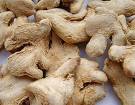Ginger
Zingiber officinaIe Zingiberaceae Originally from Asia, gil1ger is now cultivated in Africa, India, the west Indies and the USA. It is a tall, slender perennial with lance-shaped leaves and orchid-like flowers. The plant reproduces through its rhizome (rootstock) - the part used Medicinally and in cooking, Ginger adds a spicy, hot and aromatic flavor to many Asian cuisines. Parts usedRhizome Rhizomes are gathered at least a year after planting but must be lifted carefully as they break easily. . Root ginger is used fresh or dried. . Dried ginger is used for infusions, extracts and tinctures and in many pharmaceutical products. ConstituentsGinger is rich in aromatic volatile oils. These oils are its medically active constituents, and also give ginger its characteristic aroma and flavour. Ginger oil contains sesquiterpenes (known to be anti-inflammatory), particularly zingiberene. It also contains monoterpenes and aldehydes. These constituents have been shown by recent research to inhibit one of the most widespread common cold viruses. Pungent components called gingerols are thought to be responsible for ginger's antinausea effect. CAUTIONS
Medicinal usesGinger is a strong circulatory stimulant. It has an anticlotting effect and is a vasodilator - so it can help to combat . It also promotes good digestion and is antispasmodic. Ginger has a sedative effect and also reduces nausea and vomiting, including travel sickness. A study in 1990 at 5t Bartholomew's hospital, London, found that ginger reduced the incidence of nausea for postoperative patients. Its efficacy was comparable with metoclopramide, a widely used antiemetic drug. Research published in the Journal of Nutrition in 2000 showedthat an extract of ginger reduced blood cholesterol levels as well as inhibiting low-density lipoprotein (LDL) oxidation. This suggests that ginger could help to protect against the development of atherosclerosis and heart disease. Ginger can help to sweat out a cold. It is an antiseptic expectorant and thus helpful for treating catarrhal coughs. It is also reputed to lower fever. Australian studies in 2000 revealed that several constituents of ginger had an anti-inflammatory effect.It may, therefore, be helpful for chronic inflammatory conditions such as arthritis. The essential oil is prescribed for external use in a rub for rheumatism and muscular pain.Its antispasmodic effects make ginger a helpful remedy for period pains and digestive cramps. It can also cure flatulence and diarrhea. CultivationGinger is a tropical plant, so must be grown indoors or in a heated greenhouse. Plant rhizomes in a sunny or slightly shady position in a neutral to alkaline soil, and keep well watered. PREPARATION AND DOSAGEFor internal use TO TREAT nausea and vomiting, poor digestion. period pains, flatulence, diarrhoea For external use TO TREAT painful muscles or joints IF SYMPTOMS PERSIST CONSULT A DOCTOR |

Ayurveda Book
This book on Ayurveda is meant for people interested to know about basics concepts of Ayurvedic healing and learn ayurveda concepts. Though there are many books Read More My SitesReal Testimonials
Connect with us |







